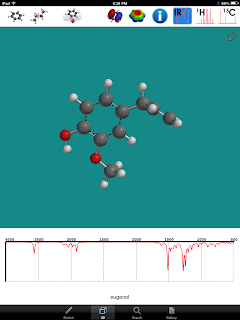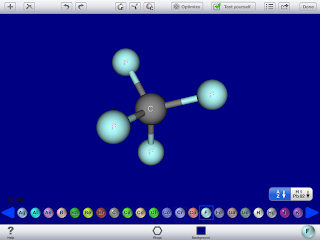I used to think that teaching was essentially teacher centered. The teacher would convey knowledge in the form of lecture and the students would absorb it. Of course the students had to study in order to commit this knowledge to memory and deepen understanding, but this lecture model was the best way to teach in my mind. In short, this is teaching by telling.
It didn't work so well. I distinctly remember when I realized this many years ago. It was gas laws. Yes those gas laws get 'em every time! I thought I did it so well. I lectured with enthusiasm. I showed the "wow" kind of demos like the collapsing can. I lectured. I had them do the lab where the students calculate the molar volume of a gas. I lectured on the gas laws. I showed cool video demonstrations. I modeled the way to do calculations. I gave a quiz. The students all failed the quiz. Do you see the pattern here? I,I, I,I...I failed! But with failure comes learning.
The need for meaningful experience in the process of learning
It started to hit me when I asked my students. "You know when you are washing dishes and put a cup full of air upside down...what happens?"
"We have dish washers teacher!"
I realized my students did not have many of the experiences that I had had growing up that implicitly taught me about gases. So I decided to give them more experiences. Perhaps the reason they did not do well on the abstract calculations was because they did not understand the concepts behind the calculations!
The next year I ordered a set of Boyle's Law Apparatus. This is basically a syringe with a block on top and a block on the bottom so that you can stand it up freely. It also allows one to stack weights, like books, on top. It is very simple.
If you push on the blocks, you feel the invisible gas push back!
Finding Misconceptions
I then had the students draw diagrams, I called them "Black Box Diagrams", by which the student would have to draw what they imagined was what was going on inside the syringe at the molecular level. What they drew astounded me. I made them draw two diagrams, one with very little weight on the top block and one with lots of weight on the top block. The students were all over the map. Several drew the molecules as if they were balloons. With little external pressure on the apparatus the ballon-like molecules were large and with much pressure the balloon-like molecules shrunk! I had no idea they thought this way! They did not grasp the fundamental concept that the molecules are not changing at all. The molecules simply bump into each other more with increased pressure. Then I asked the students, "What is in between these molecules you drew." Almost unanimously I heard them answer, "Air!" I would always get one or two students in a class that would say, "Nothing, it's empty space." But again the majority proved that they had so many misconceptions about gases. (Sort of like I too had misconceptions about teaching and learning.)
But I realized that I intuitively had an understanding of gases that I had built up over years of experience and guidance from my teachers and through struggle. This made Charles' Law and it's algorithms in my mind just a natural and direct consequence of that intuition. My students did not have the same experiences. So either they came to an understanding of gases that had some misconceptions or they simply made up their theories. I suspect it was a little of both. Nevertheless they had ideas of gases that stood as a roadblock to understanding the abstract concepts of Boyle's, Charles' and Gay-Lussac's laws and the uses of them in calculations.
Our current understanding of the brain backs this up. We are constantly forming chemical connections between the proteins which make up our brain cells. Although I think learning is more than just brain chemistry, connections between brain cells are necessary. But what if a brain connection is made that represents a false idea? Would that pose a problem to developing a correct understanding? Is it possible that a misconception, "bad brain connection" must be disconnected and then reconnected in a new "good brain connection"?
If this is the case and much of brain research seems to say it is, then I need to have my students confront their misunderstandings about science (disconnect past connections in the brain) and form new connections that represent a more correct understanding of the science concepts.
Constructivist learning theory
This theory of learning is called in the academic world Constructivism. Now some will go so far as to say that students construct reality or students construct knowledge. I don't go that far. Knowledge of reality is something outside of me that is correct whether I say so or not. For example I don't construct knowledge of sulfuric acid. The knowledge of the reality about sulfuric acid is what it is no matter what I think. I certainly can have misconceptions of acid. That would have serious consequences. But I do think we construct our understanding of of this knowledge about such things as molecules and sulfuric acid.
Teacher as facilitator
And so my students construct their own understanding of of the world. I play a part in that by providing experiences for them, sharing my own experiences, giving lectures, asking them questions that make them think, etc. But I believe one thing for sure: My students don't come to me with blank slates for minds that I just fill in for them with my words. They have much prior understanding that I as a teacher must probe and understand so that I can help them understand abstract chemistry concepts. Often that probing reveals an incorrect understanding by one of my students. I think my job at that point is to create a learning experience for them in which they come face to face with that misconception and help them struggle to gain a better understanding. More and more I see my role as a facilitator of learning. This takes the focus off of me. The students' needs for forming good conceptions come to play a bigger role in what drive my teaching.
iPads help students construct knowledge
I think the iPads are a wonderful tool for students to develop their deeper understanding of scientific concepts. You can almost see the connections forming in their brains as they plan their presentation and begin to develop an explanation for the chemistry behind the experiment. This especially was visible to me when I had them produce a presentation in groups. Their wheels are really turning. They want to get it right! I have one student who produces high quality written lab reports that are very organized and the student gets good lab results, but sometimes this student does not quite explain the chemistry correctly. I have witnessed this student get better at it as time has gone on.
The current assignment was to create a digital lab report for simple and fractional distillation. In the presentation they had to explain the difference between the two types of distillation. These concepts are pretty high level. When writing a lab report, the discussion is pretty one-dimensional. But with a screen cast, there is verbal explanation but also diagrams, pictures, and graphs that the student must use to explain the chemistry. I think this is heavy construction! Can anyone say "physical chemistry" without flinching?
Students own their learning
In Organic Chemistry I have wanted my students to create digital lab reports that demonstrate this deep understanding. The biggest challenge for most has not been the chemistry, it has been learning how to use the iPads and the apps. The term "digital native" might not be as good a description as I once expected. But by the middle of the semester I think my students have arrived at the point where they are producing some high quality screencasts. Usually we spend two days on distillation, one for simple and one day for fractional. But this time I thought I would try to do both in one day and give the students the other three hour lab period for working on their screen cast. The students made a good start on their screencasts in three hours but most needed more time. I told them that they could come in any time I am on campus and check out an iPad. I also gave them a week to complete the assignment. Most of them either used their own iPads, I think six students either had their own at the beginning of the semester or convinced their mom and dad to get them one, or they borrowed one from a friend. Of fifteen students only one was unable to complete turn in the screen cast URL on the due date. I let this student have the extra time needed to get it done. I could see the student was getting stressed out and taking it very seriously so I had no problem giving extra time. Here are some of the best screencasts using the app Explain Everything.
You can see that each student took a different approach to explaining the difference between simple and fractional distillation.
Where to go from here
We are now well over half way through the semester. I still think it is very important that the students write. I want them to write well. I tell them that they will probably forget much of the chemistry they learn in my class. But there are two more important things I want them to learn. The first is how to learn. If I can equip them to be learners of difficult concepts on their own, what more could I want. Well I also want them to be good communicators. This involves both speaking, clearly articulating heavy concepts in a way that is understandable, and it involves writing, making a claim and backing it up with solid evidence.
I plan to have the students create their own lab reports for the caffeine extraction lab. And I think I want to have them create one more report after that, perhaps a synthesis that involves explaining the mechanism. I also want to give them at least one more "digital quiz" before the semester ends. Now that they have spent so much effort learning the technology, I want them to feel like they can create a good presentation of heavy chemistry easily. Stay tuned.









